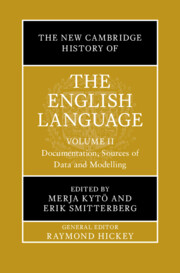Book contents
- The New Cambridge History of the English Language
- The New Cambridge History of the English Language
- The New Cambridge History of the English Language
- Copyright page
- Contents
- Figures
- Tables
- Contributors to Volume II
- General Preface
- Abbreviations for Corpora and Other Electronic Resources
- General Editor’s Introduction
- Introduction to Volume II
- Part I The Textual Record
- Part II Lighthouse Works and Authors
- 14 Beowulf as a Source Text for Archaic Features
- 15 Language Use in Chaucer’s Canterbury Tales
- 16 Shakespeare’s Language
- Part III Genre and Medium in the Record
- Part IV Modelling the Record: Methods and Theories
- Appendix: List of Corpora and Other Electronic Resources
- Index
- References
16 - Shakespeare’s Language
from Part II - Lighthouse Works and Authors
Published online by Cambridge University Press: 18 October 2025
- The New Cambridge History of the English Language
- The New Cambridge History of the English Language
- The New Cambridge History of the English Language
- Copyright page
- Contents
- Figures
- Tables
- Contributors to Volume II
- General Preface
- Abbreviations for Corpora and Other Electronic Resources
- General Editor’s Introduction
- Introduction to Volume II
- Part I The Textual Record
- Part II Lighthouse Works and Authors
- 14 Beowulf as a Source Text for Archaic Features
- 15 Language Use in Chaucer’s Canterbury Tales
- 16 Shakespeare’s Language
- Part III Genre and Medium in the Record
- Part IV Modelling the Record: Methods and Theories
- Appendix: List of Corpora and Other Electronic Resources
- Index
- References
Summary
This chapter takes a perspective on Shakespeare’s language that is more in tune with linguistics than literary criticism. Hence, it covers areas of language typically and traditionally discussed within linguistics, including phonology, grammar, lexis and semantics, but also includes pragmatics and, briefly, Conversation Analysis. It begins with a consideration of the label ‘Shakespeare’s language’ and what exactly that might encompass; the role of Shakespeare’s language in the study of the history of English; and popular myths that have arisen around Shakespeare’s language. It concludes with a reflection on methods of study, especially digital methods. It strives not only to acknowledge key research, but also to give the flavour of some of the findings of that research.
Information
- Type
- Chapter
- Information
- The New Cambridge History of the English LanguageDocumentation, Sources of Data and Modelling, pp. 385 - 406Publisher: Cambridge University PressPrint publication year: 2025
References
Accessibility standard: WCAG 2.0 A
Why this information is here
This section outlines the accessibility features of this content - including support for screen readers, full keyboard navigation and high-contrast display options. This may not be relevant for you.Accessibility Information
Content Navigation
Allows you to navigate directly to chapters, sections, or non‐text items through a linked table of contents, reducing the need for extensive scrolling.
Provides an interactive index, letting you go straight to where a term or subject appears in the text without manual searching.
Reading Order & Textual Equivalents
You will encounter all content (including footnotes, captions, etc.) in a clear, sequential flow, making it easier to follow with assistive tools like screen readers.
You get concise descriptions (for images, charts, or media clips), ensuring you do not miss crucial information when visual or audio elements are not accessible.
Visual Accessibility
You will still understand key ideas or prompts without relying solely on colour, which is especially helpful if you have colour vision deficiencies.
Structural and Technical Features
You gain clarity from ARIA (Accessible Rich Internet Applications) roles and attributes, as they help assistive technologies interpret how each part of the content functions.
